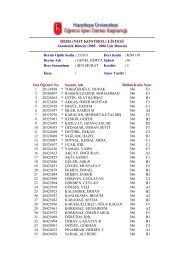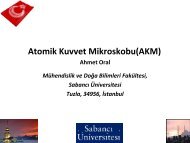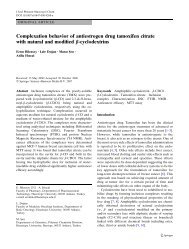Factors affecting the complexation of polyacrylic ... - ResearchGate
Factors affecting the complexation of polyacrylic ... - ResearchGate
Factors affecting the complexation of polyacrylic ... - ResearchGate
Create successful ePaper yourself
Turn your PDF publications into a flip-book with our unique Google optimized e-Paper software.
2742 DUBOLAZOV ET AL.takes place, but in <strong>the</strong> latter case <strong>the</strong>re is only adistribution <strong>of</strong> Me þ metal ions near <strong>the</strong> polymerchain and no real binding <strong>of</strong> monovalent metalions. 30 Attraction between PAA and Me þstrongly affects <strong>the</strong> electric field <strong>of</strong> polymer surface,which can lead to <strong>the</strong> rearrangement <strong>of</strong>PAA structure. As a general rule <strong>the</strong> increase insalt concentration <strong>of</strong> <strong>the</strong> medium changes <strong>the</strong>conformation <strong>of</strong> <strong>the</strong> polymer chains to a morecompact form. 31 In our case this factor probablyleads to <strong>the</strong> enhancement <strong>of</strong> hydrophobicity aswell as stability <strong>of</strong> PAA/UO 2þ2complex.Recently Iida observed <strong>the</strong> similar effect <strong>of</strong>KCl on activity <strong>of</strong> Ca 2þ in aqueous PAA solution,using a Ca 2þ ion sensitive electrode. The Ca 2þactivity in <strong>the</strong> PAA solution at <strong>the</strong> low degree <strong>of</strong>neutralization was increased by <strong>the</strong> presence <strong>of</strong>dilute KCl and decreased by <strong>the</strong> presence <strong>of</strong> concentratedKCl. 32The size effect seems to be obvious explanationfor <strong>the</strong> influence <strong>of</strong> Me þ nature on <strong>the</strong>stability <strong>of</strong> PAA/UO 2þ2polycomplex. Kim and coworkers31 found that in <strong>the</strong> solutions containingalkali metal ions, aggregation <strong>of</strong> PAA wasincreased in <strong>the</strong> order Li þ < Na þ < K þ < Cs þ ,which means that <strong>the</strong> hydrophobicity <strong>of</strong> <strong>the</strong>chain decreases with increasing solvated radius<strong>of</strong> <strong>the</strong> counterion. As it can be seen from Figure4, <strong>the</strong> addition <strong>of</strong> KNO 3 has more pronouncedeffect on increasing <strong>of</strong> I/I 0 value than NaNO 3 aswell as on <strong>the</strong> critical concentration <strong>of</strong> complexprecipitation (see Fig. 5). Indeed, <strong>the</strong> radius <strong>of</strong>hydrated Na þ (R H 4Å) is bigger than that <strong>of</strong>K þ (R H 3Å). 33 Therefore in our case condensationforce is higher for K þ , which can stabilizeand favor <strong>the</strong> aggregation <strong>of</strong> PAA/UO 2þ2polycomplexat lower concentrations than Na þ . Considering<strong>the</strong> difference in <strong>the</strong> critical concentration <strong>of</strong>complex aggregation at <strong>the</strong> onset <strong>of</strong> phase separation,we conclude that <strong>the</strong> PAA/UO 2þ2 /KNO 3complex is more hydrophobic and stable thanPAA/UO 2þ2 /NaNO 3.The effect <strong>of</strong> concentrations <strong>of</strong> H þ , NaNO 3 ,and KNO 3 on quenching <strong>the</strong> luminescent intensity<strong>of</strong> UO 2þ2complexed with PAA has been analyzedby constructing relevant Stern–Volmerplots, namely, I 0 /I versus quencher concentrations,using <strong>the</strong> following relation:Figure 5. Effect <strong>of</strong> inorganic salts NaNO 3 (1) andKNO 3 (2) on <strong>the</strong> turbidity <strong>of</strong> PAA/UO 2þ2aqueous solutions.k ¼ 400 nm, pH ¼ 3.13, PAA/UO 2þ2¼ 2.I 0 =I ¼ I þ k q hs 0 i½QŠwhere I 0 and I are luminescent intensities in <strong>the</strong>absence and presence <strong>of</strong> quencher, k q quenchingrate constant, hs 0 i average lifetime <strong>of</strong> <strong>the</strong> uranylion in water and [Q] concentration <strong>of</strong> quencher.The data presented in Figures 3a and 4 were<strong>the</strong>refore used to prepare Figure 6. The inset inthis figure is for H þ ions. Ascending parts <strong>of</strong> <strong>the</strong>curves correspond to quenching <strong>of</strong> luminescenceby corresponding salts or acid. By taking <strong>the</strong> hs 0 ivalue as 5 ls, which is typical average lifetime <strong>of</strong>UO 2þ2in aqueous solutions, 14 and using <strong>the</strong> slope<strong>of</strong> ascending parts <strong>of</strong> <strong>the</strong> curves <strong>of</strong> Figure 6quenching rate constant k q was calculated andlisted in Table 1. By analogy to <strong>the</strong> effect <strong>of</strong>quenching, <strong>the</strong> descending parts <strong>of</strong> <strong>the</strong> curveswere evaluated similarly to calculate <strong>the</strong> rateconstants for enhancement effect, where <strong>the</strong>coefficient k q in above given equation is replacedby k e . Both results are listed in Table 1. Thequenching rate constant k q ¼ 1.7 10 8 M 1 s 1determined for H þ is in very good accordanceFigure 6.3a and 4Stern–Volmer plot <strong>of</strong> <strong>the</strong> data <strong>of</strong> Figures








